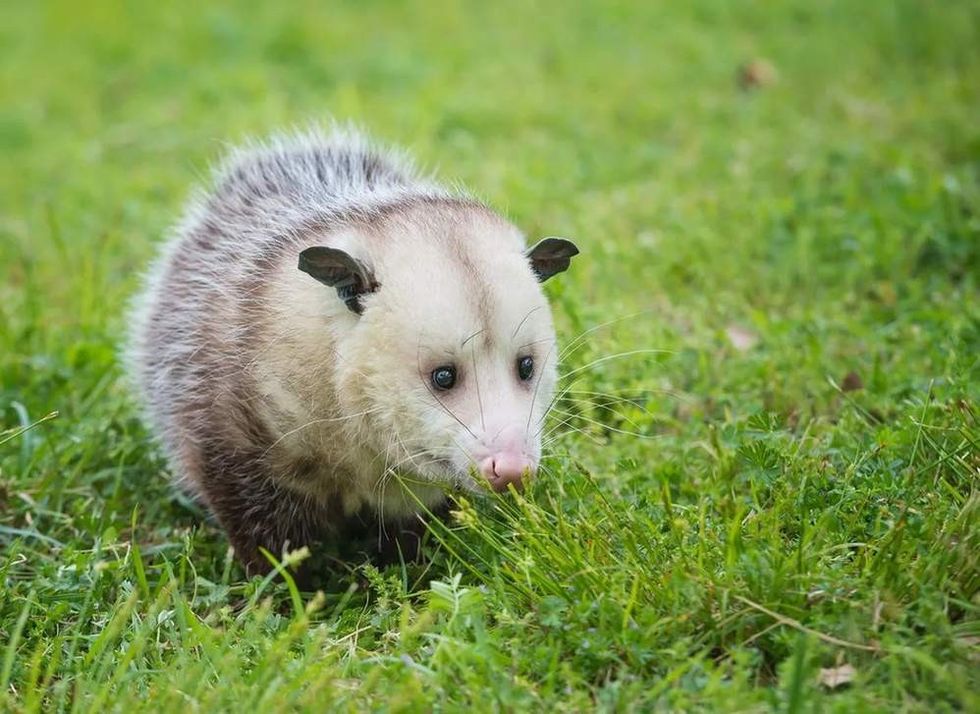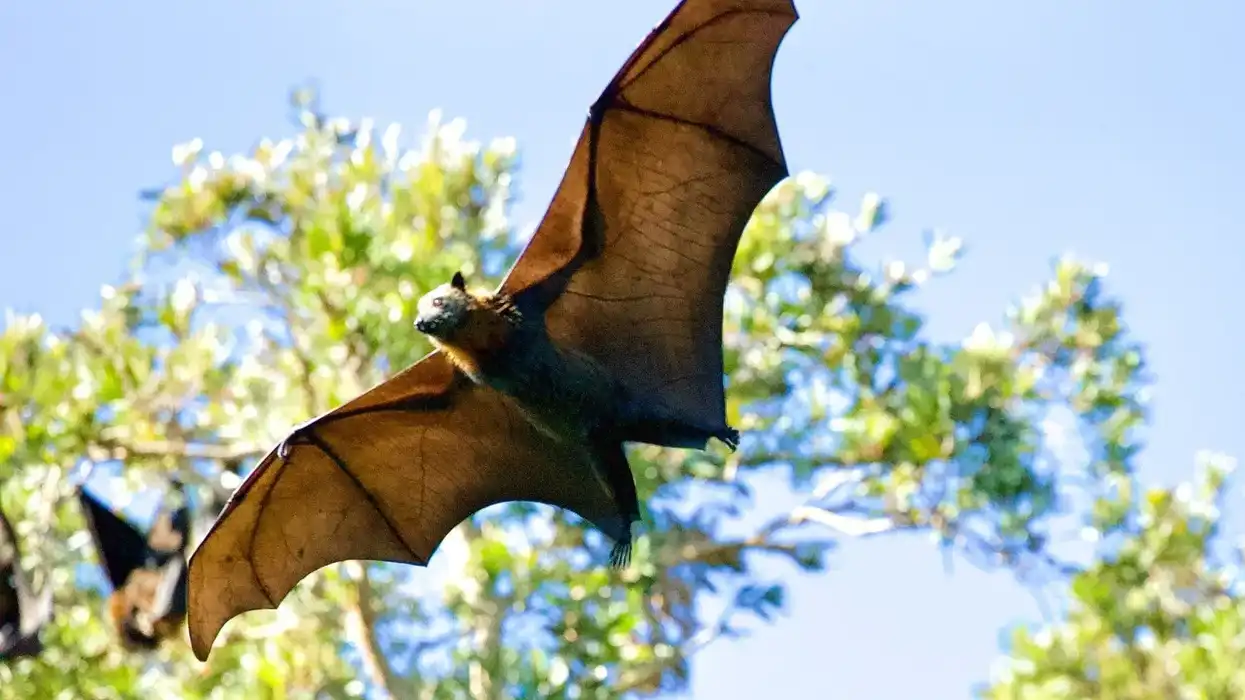The Virginian opossum is the only native marsupial (pouched mammal) species to exist in North America with a stable population. They are about the size of a small dog and are scavengers in nature.
They scavenge through garbage piles in human settlements and help us get rid of harmful bugs and insects like ticks, beetles, and cockroaches. Along with this they also help get rid of animal carcasses as they are known to prey on small animals like rats.
They are often seen as big ugly rats but are in no way related to any rodent. They have a coarse look to them with their ragged appearance and their long, unkempt whitish fur and a pointed ratlike snout with naked ears.
They have a long tail that is almost as long as their entire body and whiskers around their mouth that act as a sensor.
These creatures are nocturnal in nature and are solitary, excluding females who are raising their young. They are shy in nature and act passive, but in conflict, they can be aggressive and hiss and growl at animals they see as threats.
If you enjoyed our fun facts about Virginia opossum, you might also want to read our articles on the kob and the ringtail possum too.
Virginia Opossum Interesting Facts
What type of animal is a Virginia opossum?
The Virginia opossum (Didelphis virginiana) is the only living opossum found in North American regions and is a marsupial along with being one of the most primitive animals in existence. They have survived for more than 65 million years without the need for a change in their external body, this has led to them being termed as 'living fossils'.
What class of animal does a Virginia opossum belong to?
Virginia Opossum belongs to the mammal class of animals.
The presence of mammary glands to feed their young one, along with three ear bones, fur or hair, and the neocortex (region of the brain), are the defining factors of mammals.
They belong to the marsupial family, meaning the young crawl into the pouch of the mother after they are born, just like in the case of Kangaroos.
How many Virginia opossums are there in the world?
There is no record for the total population of Virginia Opossum in the world. But thankfully their global population is on the rise as these animals are found in abundance in North America and other parts of the globe.
Where does a Virginia opossum live?
Virginia opossums can be adaptable and can be found in wetlands, farmland, and many urban areas near human habitats. They make their dens near wooded areas as they prefer being close to water sources. They do not sleep at night as they are nocturnal animals and forage around their habitat for food and new shelter at night.
What is a Virginia opossum's habitat?
A Virginia opossum's habitat can be a wide range, but mostly they prefer areas that are close to water sources, such as a swamp or a stream. This opossum can live in woodlands and thickets as well, and they are found roaming around human-altered areas.
They are adept at adapting to new regions and habitats which helps these animals thrive in urban as well as suburban regions.
Their small bodies and their nocturnal nature with their high litter count allow them to increase in population in a wide range of habitats. A home range of 12-264 acres has been reported!
Who do Virginia opossums live with?
Opossums are mostly solitary animals as they are poor at socially mixing with other opossums. The females can live in groups occasionally but males cannot as they fight whenever they are in the presence of another male.
They are also known as being solitary wanderers and seldom remain in one location for more than a few days, they seek out new habitats and move along in the cover of bushes, or man-made structures by day.
How long does a Virginia opossum live?
Compared to other small mammals, including the marsupial family, the Virginia opossum lifespan is unusually short for its size and metabolic rate. They have a maximum lifespan of around one or two years in the wild and three or four years in captivity.
Their short lifespan is mostly due to their poor defense against predators and constantly becoming prey to human interference.
In the United States, they are found along the west coast and east of the Rocky Mountains.
How do they reproduce?
Virginia opossums (Didelphis virginiana) sexually mature within the first year of their life. Females mature at around six months and males at eight months.
Breeding, however, begins when they are 10 months of age. They have a long breeding season, the seasons for which vary based on the individual's location and have one to three litters per year. The breeding season can either be from February to September or January to August.
The gestation period for the females is 11-13 days and their young ones have a high mortality rate, for example, one in ten offspring survive to adulthood.
What is their conservation status?
The Virginia opossum (Didelphis virginiana) is listed as the least concern by the IUCN Red List of threatened species. Opossums' ability to adapt to urban and suburban habitats alongside humans has made them extremely successful and widespread. They tolerate human settlements and flourish in them with humans helping them by exterminating their predators.
Virginia opossum Fun Facts
What do Virginia opossums look like?

The Virginia opossum, native to North American regions, has a long head and a pointed snout, with round naked ears with long whiskers around their noses and a scaly, almost hairless, prehensile tail which is almost half of its total length. Virginia opossum skull can be between 3 and 6 inches long (7.6- 15.2 cm).
They have five toes on their fore and hind legs which are accompanied by sharp claws, excluding the thumblike innermost toe found on the hind leg.
How cute are they?
These furry creatures with their soft fur are cute to the core! They might look scary showing off their 50 razor-sharp teeth which they do only to scare predators. Other than that, these critters are cute, especially young opossums!
How do they communicate?
Virginia opossums communicate through a variety of methods, which include chemical, vocal, and visual signals.
When they are threatened by predators or human interaction, they make hissing, growling, or a clicking sound, which is accompanied by them flashing their sharp teeth and arching their back.
They are known to 'play possum' in case of a predator attack or when frightened, where they voluntarily fall over and can become unresponsive for up to six hours, acting like dead animals, and secrete a foul-smelling fluid from their anal glands which discourages predators from pursuing them.
How big is a Virginia opossum?
The Virginia opossum length varies from male to female, they have an average length of 30 in (including the tail), the female average around 28 in.
How fast can a Virginia opossum run?
In cases of being threatened, Virginia opossums can run away at speeds of around 4 miles per hour (6.4 kph) and leave their predators trailing!
How much does a Virginia opossum weigh?
Males can range from 1.7-14 lb (0.7-6.3 kg) and in cases of females, the weight range is 11 oz-8.2 lb (0.3-3.7 kg)!
What are their male and female names of the species?
A Male opossum is called a Jack and a female is called a Jill.
What would you call a baby Virginia opossum?
Much like in the cases of kangaroos, the young opossums are called Joeys.
After a gestation period of fewer than two weeks, jelly-bean-size opossum babies crawl their way to their mother's pouch, living in them for up to three months. And as they grow a bit older they climb onto their mother's back by clutching onto her fur and eventually get off after a month or two.
What do they eat?
The Virginia opossum's diet is a wide variety of plants and animals as these critters are omnivorous in nature and can have a diet that consists of insects, frogs, worms, birds, fruits, carrion (the corpse of dead animals), and nuts. Virginia opossum's also prey on small rodents, shrews, and moles.
In human settlements, they are often seen feeding out of garbage cans, bird feeders, and compost piles.
Are they aggressive?
The Virginia opossum (Didelphis virginiana) is a very aggressive animal and will often screech, hiss, and bear all its teeth to scare off predators. They also feign death by 'playing possum' by closing their eyes and rolling over acting dead.
Would they make a good pet?
A Virginia opossum pet is a bad idea since opossums are seen as pests, it is illegal to keep them as pets in many states. They are not sold in the pet trade, and whenever they are found as zoological specimens, they are often orphans that have been raised by humans.
Did you know...
They are the only native marsupial that exists in North America.
The name Virginia opossum comes from the original name of the animal 'Opossum' meaning 'white animal' which is a direct English translation of the word 'Algonquian wapathemwa'.
Opossums are smart! They have an amazing ability to find food and remember the exact location. In tests, they have outperformed rats, rabbits, cats, and dogs in their ability to find food!
Opossums have an impressive prehensile tail that they use as a hand! These tails are long, almost as long as the opossums themselves, and these tails can grasp, carry and wrap around things like tree branches. The tail also aids in maintaining balance.
Opossums play a vital role in the ecosystem as they are natural pest controllers. They prey on snails, beetles, rats, cockroaches, ticks, and other insects and animals that can be harmful to humans. They play the role of scavengers and help reduce carcasses in their home range.
Opossums are resilient and are immune to several snake venoms as their low body temperature prevents them from contracting rabies.
Although the common opossum and Virginia opossum may seem similar, they are in fact two different species. The common opossum's scientific name is Didelphis marsupialis, whereas the Virginia opossum scientific name Didelphis virginiana.
Virginia opossum tracks are almost like a human baby's handprint because of their inner toe on each hind foot that lacks a claw and resembles a thumb.
If you happen to come across an orphaned joey, you can take care of it by building a home for it!
All you need to do is make a box and put it at least 4.6 yds (4 m) from the ground, and make sure the box faces away from winds and does not face the afternoon sun.
Make sure your box has a flexible metal strip at the bottom and make sure not to nail the box in too deep into the tree.
And to prevent your opossum from contracting diseases, make sure you get them the proper vaccinations!
What does the Virginia opossum do when frightened?
In cases of being caught on the ground and unable to find an escape, they become catatonic. They fall over and appear to be dead or unconscious while maintaining their normal body function. The expression 'play possum' was derived from these creatures and their ability to escape predators by playing dead.
How many teeth do Virginia opossums have?
Opossums have 50 razor-sharp teeth which is the highest number of teeth that can be found in any land mammal!
Here at Kidadl, we have carefully created lots of interesting family-friendly animal facts for everyone to discover! Learn more about some other mammals including the aye-aye and the gray fox.
You can even occupy yourself at home by drawing one of our Virginia opossum coloring pages.









